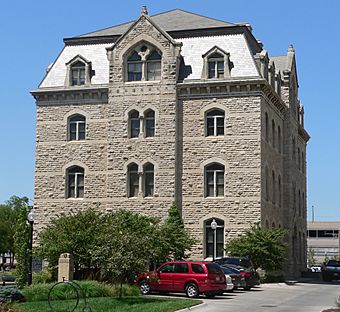City Hall (Lincoln, Nebraska) facts for kids
Quick facts for kids |
|
|
City Hall
|
|
 |
|
| Location | 920 O St., Lincoln, Nebraska |
|---|---|
| Area | less than one acre |
| Built | 1874 |
| Architect | Office of the Supervising Architect under Alfred B. Mullett and William A. Potter |
| Architectural style | Gothic |
| NRHP reference No. | 69000132 |
| Added to NRHP | October 15, 1969 |
Lincoln City Hall is an important historic building in Lincoln, Nebraska. It used to be where the city government worked. The building was constructed between 1874 and 1879.
It was first built to be a U.S. Post Office and Court House. The design came from the office of Alfred B. Mullett, a government architect. Later, in 1906, a new post office was built. This old building then became the city hall.
In 1969, the city government moved again. They moved to the new City-County Building. So, this historic building stopped being the city hall. While Mullett is the official architect, his assistant, William Appleton Potter, likely did much of the design work. Potter was known for his Gothic style buildings.
Contents
What Does Lincoln City Hall Look Like?
Building Materials and Size
Lincoln City Hall is made of brick. The outside is covered with rough limestone blocks. It has four floors, plus a basement. The building is about 60 feet wide and 90 feet long.
Gothic Style Architecture
The outside of the building shows a strong High Victorian Gothic style. This means it has many details common in Gothic buildings. It also has a special roof called a mansard roof. This type of roof has slopes on all sides.
The inside of the building also has Gothic details. You can see these in the wooden parts. The famous art critic John Ruskin influenced this style. His ideas were very popular at the time.
Why is Lincoln City Hall Important?
A Place on the National Register
Lincoln City Hall is a very special building. On October 15, 1969, it was added to the National Register of Historic Places. This is a list of important places in the United States. Being on this list helps protect historic buildings. It means they are recognized for their history and design.



